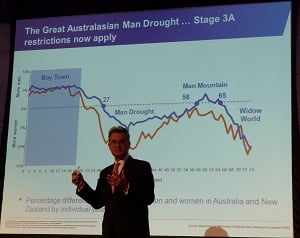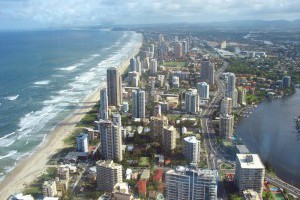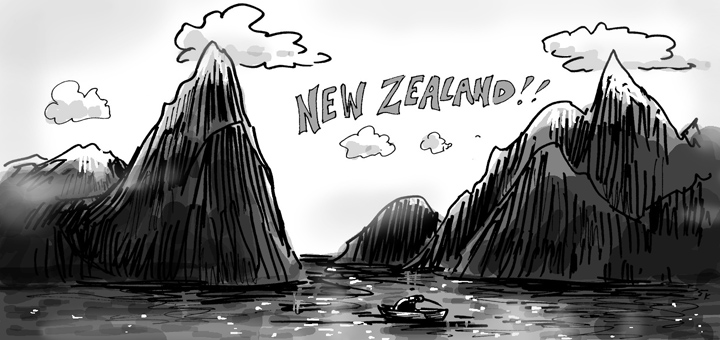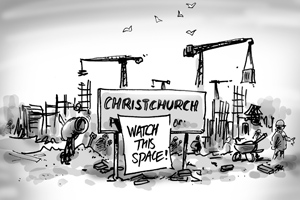A crew from .id (Ivan, Simone, Glenn and Lailani) attended and presented at the two day Beyond the Count conference (3-4 March) held by the ABS to promote the use of Census data. We noticed that not so many of our local government clients were able to attend, so we thought we’d provide a quick synopsis of the sessions we attended and the gems we gleaned … not least of all that the Census really is a national treasure.

The Census – a national treasure
The ABC’s Steve Cannane MCed the event and kicked things off with a great story about how he uses Census data to explode myths generated by pollies and spin merchants. When researching a story about Scientology in Australia, he checked their claim that it was the fastest growing religion, against the Census data. He discovered that in 2006 there were 2506 Scientologists in Australia – less than the number who registered as Jedi Knights …
Brian Pink, the Australian Statistician, opened the conference. He reminded us that the 2011 Census will be the 16th Australian Census, over 100 years. It is the largest logistical peacetime operation in Australia with contact made with every household in the nation and employing 43,000 field staff. Every 5 years the Census offers us a snapshot of the nation, and the series of 16 Censuses capture our national journey over the past 100 years. It builds insights and knowledge that help improve people’s lives, and underpins our democratic system of government through the creation of electoral boundaries and the allocation of funding on the basis of population. The data is publicly available and is used by big and small business, financial institutions, journalists, councils, community organisations, schools and universities. All in all it generates a massive return on investment and is a national treasure.
Long term trends – the value of time series
Bernard Salt then gave his usual dynamic performance. He spoke particularly to the value of time series for understanding social trends. These include his analysis showing the shift of Australian’s to the coast (sea change), the move from our past, largely Mediterranean, migration history , to a new Asian migration era and the implications for our lifestyles as we assimilate new habits from our new migrant cultures. He speculated that we might move from being a nation of coffee drinkers to tea drinkers again, and that our housing may begin to incorporate Feng Shui elements. And of course he showed the poor, man-drought affected women where to find a bloke.
He spoke of something which is close to .id’s heart, which was the importance of turning data into stories that answer the key questions for decision makers – “Are we in the right place at the right time offering the right product/service?”

Bernard Salt spoke about the ABS 2008 population projections which have a high, medium and low series. He said that the ABS consulted respected demographer Professor Peter McDonald, about the number of overseas migrants we need as the baby boomers begin to exit the workforce. 180,000 thousand was the answer and formed the basis of the net overseas migration assumptions for the medium series which results in a population of 35,470 million by 2056.
This is not a high road and exposes the ridiculousness of the population debate at the last election. There will be an exodus of baby boomers from the workforce in the next five years which will create a problem for Australia if we close down migration. Particularly as Australia and NZ are vulnerable to the brain drain in a global economy which draws our young people overseas. The figures point to shortages in occupations such as nursing, heavy truck drivers, farming occupations and religions ministers. I had to think about the latter – but apparently people become more religious as they age and there is likely to be an increased demand for religious ministration as the baby boomers seek to ease their way into the next life …
Improving Census collection in indigenous communities – will it work?
The ABS has put a lot of effort into addressing the problems of Census collection in indigenous communities (more on this later). Peter Yu – CEO, Nyamba Buru Yawuru Ltd in Broome presented a different way of thinking about this – and how they are addressing it in his country.
He said that Aboriginal people are the most researched people on earth – but that it has been of little use to them. He says that the ABS has seen the problem of the indigenous under count as technical challenge and that they have not been successful in resolving it – with a recognised under count of 11%, 16% in the NT and in some areas up to 33%. This means that governments are forced to rely on inaccurate numbers which disadvantages Aboriginal people. For example, the people in Fitzroy Crossing were denied a TV transmitting station as the population was under the official number required. He said Aboriginal people have an aversion to research and data due to historical experiences of being excluded or data being used to undermine their position.
He said that the reason the under count is now being treated seriously (an additional $20m is being spent to get a better count in 2011, according to the ABS) is because of the adoption of the Government’s evidence-based “Closing the Gap” policy which relies on data to measure the gap and to provide evidence about whether the policies are working. He said that reliance on poor data is a fundamental flaw with the Closing the Gap policy.
More serious though is that the underlying assumption is wrong. Closing the Gap assumes indigenous well being has improved when it is the same as white people’s well being. It is blind to the inherent value of Aboriginal society and culture. Nowhere on the Census form, for example, can you say you are a traditional owner. Someone could meet all the indicators of well being according to the dominant culture, but be considered poor by Aboriginal standards because they had lost their language, culture and relationship with the land.
Peter believes that because the Census does not measure the fundamental values of Aboriginal culture, it will become an entrenched tool of assimilation. Unless the ABS uses indicators that are selected by Aboriginal people to measure Aboriginal people’s well being, the data will only be of value to government and not to the people. He would like to see Census questions about aboriginality, kinship, cultural obligations and taking care of land – all important issues to Aboriginal people. We need to build an evidence-base consistent with Aboriginal people’s aspirations.
In the Yawuru Settlements in Broome where the people have won native title they are doing just that. They recognise the importance of having accurate data and are showing leadership by building a longitudinal survey which includes a count as well as measures of geographic mobility, traditional affiliation, identification and language. The Yawuru Wellbeing Index will measure things of importance to Yawuru including family and kinship, connection to culture and acceptance by the dominant society.
Counting the homeless
This was a big topic of discussion throughout the conference.
Under the Rudd Government, there was a commitment to halving homelessness by 2020. This year’s Census will be the first chance we have to measure whether the associated interventions are having any affect.
Counting the homeless is notoriously difficult to count because homeless people move around, don’t want to be counted, and are difficult to categorise. For example, women who sleep rough often sleep during the day because it’s safer – but then they get missed in evening collections.
The main thing I gathered from this session, is that while we need to keep grappling with ways to improve the count, we have to be careful with any changes in methodology or we will lose the value of time series. There is now data from 1996, 2001 and 2006 – and this ability to identify patterns and trends and see if interventions are working is the greatest value the data offers. For example, even though the Census is conducted in winter, which is likely to lead to an under count in southern parts of the country, at least it is always conducted in winter so comparisons are possible.
For more information about the Census and how your service could help with counting the homeless visit the National Homelessness Information Clearinghouse.
Census IS sexy!
Our very own Ivan Motley gave an excellent insight to how.id converts Census data into information and knowledge. He showed how you can use Census data to tell the story of cities and communities – and how they are changing. He gave examples of how this is used by local government to make good investment decisions that achieve fair and equitable community outcomes – particularly with regard to housing and services. But more on this later… It was videoed, so you’ll be able to see for yourself as soon as we get our hands on it…
Census gets down to business – telling the story of the economy
And I gave a presentation about how to convert Census data into valuable knowledge about local economies – showcasing Employment by Industry Sector, Journey to Work, Place of Work and cross-tabulated workforce data. Using the City of Monash as an example, we explored an online economic profile and showed how it can be used for land use and strategic planning, local economic development and investment attraction, as well as to support local businesses and enhance funding applications.
Last word
We’ve seen the ABS change its approach to data dissemination to one of increasing openness. They now openly recognise the value of companies like .id, who add value to Census data and convert it into information for key users like local government. They are making big efforts to improve the count by engaging with Aboriginal communities, the community sector, local government and others. We are incredibly fortunate in Australia to have a national count, and to have it every 5 years. We’re excited about what the 2011 Census is going to tell us about our communities and look forward to sharing it with you.
.id is a team of demographers, population forecasters, spatial planners, urban economists, IT and data experts who use a unique combination of information, applications and consulting to help governments and organisations understand people and places for evidence-based planning.
Access our population forecasts for Local Government Areas here.











